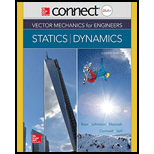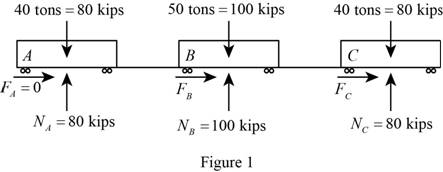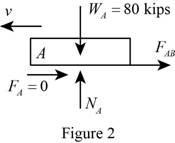
Concept explainers
(a)
Find the distance (x) required to bring the train to stop.
(a)
Answer to Problem 13.17P
The distance (x) required to bring the train to stop is
Explanation of Solution
Given information:
The initial speed of the train
The coefficient of kinetic friction
The weight of train A
The weight of train B
The weight of train C
Assume the acceleration due to gravity (g) is
Calculation:
Show the free body diagram of the train A, B and C with the forces as in Figure (1).

Convert the unit of initial velocity of trailer truck from
Calculate the force at A
Substitute 0.35 for
Calculate the force at B
Substitute 0.35 for
Calculate the force at C
Substitute 0.35 for
Calculate the total weight (W) using the relation:
Substitute
Calculate the mass of the truck (m) using the formula:
Substitute
Calculate the initial kinetic energy
Substitute
The final kinetic energy
Calculate work done
Substitute
Use work and energy principle which states that kinetic energy of the particle at a displaced point can be obtained by adding the initial kinetic energy and the work done on the particle during its displacement.
Find the distance (x) required to bring the train to stop:
Substitute
Therefore, the distance (x) required to bring the train to stop is
(b)
Find the force in each coupling.
(b)
Answer to Problem 13.17P
The force in coupling AB is
The force in coupling BC is
Explanation of Solution
Given information:
The initial speed of the train
The coefficient of kinetic friction
The weight of train A
The weight of train B
The weight of train C
Assume the acceleration due to gravity (g) is
Calculation:
Consider car A:
Show the free body diagram of the train A with the forces as in Figure (2).

Assume
Calculate the mass of the truck (m) using the formula:
Substitute
Calculate the initial kinetic energy
Substitute
The final kinetic energy
Calculate work done
Substitute
Use work and energy principle which states that kinetic energy of the particle at a displaced point can be obtained by adding the initial kinetic energy and the work done on the particle during its displacement.
The expression for the principle of work and energy is as follows;
Substitute
Consider car C:
Show the free body diagram of the train C with the forces as in Figure (3).

Calculate the mass of the truck (m) using the formula:
Substitute
Calculate the initial kinetic energy
Substitute
The final kinetic energy
Calculate work done
Substitute
Use work and energy principle which states that kinetic energy of the particle at a displaced point can be obtained by adding the initial kinetic energy and the work done on the particle during its displacement.
Find the force in coupling BC:
Substitute
Therefore, the forces in coupling AB and BC are
Want to see more full solutions like this?
Chapter 13 Solutions
Connect 2 Semester Access Card for Vector Mechanics for Engineers: Statics and Dynamics
- A 2000-kg automobile starts from rest at point A on a 6° incline and coasts through a distance of 150 m to point B. The brakes are then applied, causing the automobile to come to a stop at point C , which is 20 m from B . Knowing that slipping is impending during the braking period and neglecting air resistance and rolling resistance, determine (a) the speed of the automobile at point B, (b) the coefficient of static friction between the tires and the road.arrow_forwardIn order to determine the weight of a freight train of 40 identical boxcars, an engineer attaches a dynamometer between the train and the locomotive. The train starts from rest, travels over a straight, level track, and reaches a speed of 30 mi/h after three minutes. During this time interval, the average reading of the dynamometer is 120 tons. Knowing that the effective coefficient of friction in the system is 0.03 and air resistance is negligible, determine (a) the weight of the train (in tons), (b) the coupling force between boxcars A and B.arrow_forwardA 1-kg sphere is at rest relative to a parabolic dish that rotates at a constant rate about a vertical axis. Neglecting friction and knowing that r= 1 m, determine (a) the speed v of the sphere, (b) the magnitude of the normal force exerted by the sphere on the inclined surface of the dish.arrow_forward
- Two swimmers A and B, of weight 190 lb and 125 lb, respectively, are at diagonally opposite corners of a floating raft when they realize that the raft has broken away from its anchor. Swimmer A immediately starts walking toward B at a speed of 2 ft/s relative to the raft. Knowing that the raft weighs 300 lb, determine (a) the speed of the raft if B does not move, (b) the speed with which B must walk toward A if the raft is not to move.arrow_forwardThe coefficients of friction between the load and the flatbed trailer shown are μs = 0.40 and μk = 0.35. Knowing that the speed of the rig is 55 mi/h, determine the shortest time in which the rig can be brought to a stop if the load is not to shift.arrow_forwardA 2 kg collar which can slide on a frictionless vertical rod is acted upon by a force P which varies in magnitude as shown. Knowing that the collar is initially at rest, determine: (a) the velocity of the collar at t = 2 s, and t = 3s, (b) the maximum velocity of the collar, (c) the time when the velocity is zero.arrow_forward
- The system shown is at rest when a constant 250-N force is applied to block A . Neglecting the masses of the pulleys and the effect of friction in the pulleys and assuming that the coefficients of friction between block A and the horizontal surface are μs = 0.25 and μk = 0.20, determine (a) the velocity of block B after block A has moved 2 m, (b) the tension in the cable.arrow_forwardAn airline pilot climbs to a new flight level along the path shown. Knowing that the speed of the airplane decreases at a constant rate from 180 m/s at point A to 160 m/s at point C , determine the magnitude of the abrupt change in the force exerted on a 90-kg passenger as the airplane passes point B.arrow_forwardThe system shown is at rest when a constant 250-N force is applied to block A. Neglecting the masses of the pulleys and the effect of friction in the pulleys and between block and the horizontal surface, determine (a) the velocity of block B after block A has moved 2 m, (b ) the tension in the cable.arrow_forward
- A 5-kg collar A is at rest on top of, but not attached to, a spring with stiffness k1 = 400 N/m when a constant 150-N force is applied to the cable. Knowing A has a speed of 1 m/s when the upper spring is compressed 75 mm, determine the spring stiffness k2 . Ignore friction and the mass of the pulley.arrow_forwardA 1-lb collar is attached to a spring and slides without friction along a circular rod in a vertical plane. The spring has an undeformed length of 5 in. and a constant k= 10 lb/ft. Knowing that the collar is released from being held at A determine the speed of the collar and the normal force between the collar and the rod as the collar passes through B.arrow_forwardA car is traveling at 100 km/h along a straight, level road when its brakes become locked. Determine the stopping distance of the car knowing that the coefficient of kinetic friction between the tires and the road is 0.65.arrow_forward
 Elements Of ElectromagneticsMechanical EngineeringISBN:9780190698614Author:Sadiku, Matthew N. O.Publisher:Oxford University Press
Elements Of ElectromagneticsMechanical EngineeringISBN:9780190698614Author:Sadiku, Matthew N. O.Publisher:Oxford University Press Mechanics of Materials (10th Edition)Mechanical EngineeringISBN:9780134319650Author:Russell C. HibbelerPublisher:PEARSON
Mechanics of Materials (10th Edition)Mechanical EngineeringISBN:9780134319650Author:Russell C. HibbelerPublisher:PEARSON Thermodynamics: An Engineering ApproachMechanical EngineeringISBN:9781259822674Author:Yunus A. Cengel Dr., Michael A. BolesPublisher:McGraw-Hill Education
Thermodynamics: An Engineering ApproachMechanical EngineeringISBN:9781259822674Author:Yunus A. Cengel Dr., Michael A. BolesPublisher:McGraw-Hill Education Control Systems EngineeringMechanical EngineeringISBN:9781118170519Author:Norman S. NisePublisher:WILEY
Control Systems EngineeringMechanical EngineeringISBN:9781118170519Author:Norman S. NisePublisher:WILEY Mechanics of Materials (MindTap Course List)Mechanical EngineeringISBN:9781337093347Author:Barry J. Goodno, James M. GerePublisher:Cengage Learning
Mechanics of Materials (MindTap Course List)Mechanical EngineeringISBN:9781337093347Author:Barry J. Goodno, James M. GerePublisher:Cengage Learning Engineering Mechanics: StaticsMechanical EngineeringISBN:9781118807330Author:James L. Meriam, L. G. Kraige, J. N. BoltonPublisher:WILEY
Engineering Mechanics: StaticsMechanical EngineeringISBN:9781118807330Author:James L. Meriam, L. G. Kraige, J. N. BoltonPublisher:WILEY





